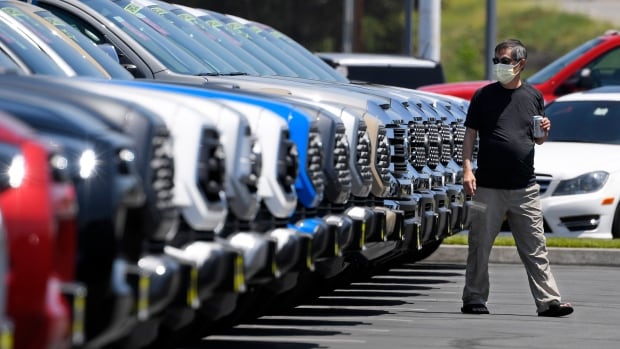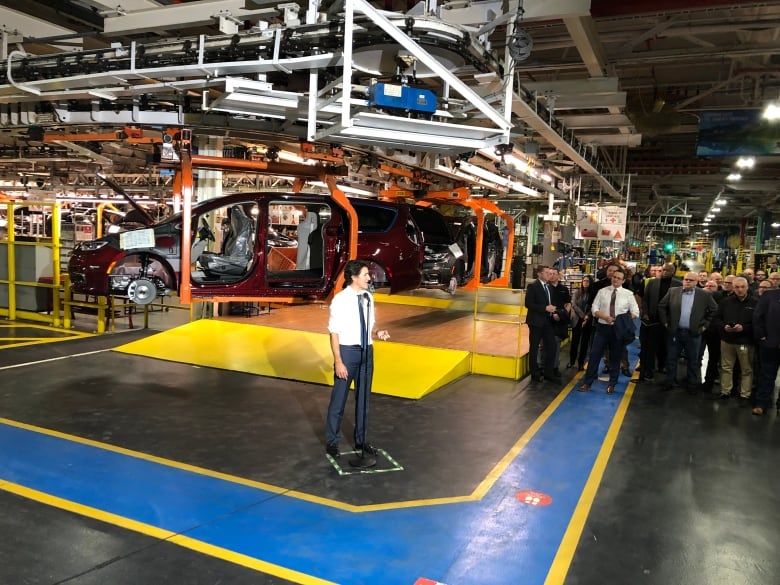
If you’re one of thousands of people looking to make the shift to a new, greener vehicle — get ready to wait.
If you’re just hoping to buy used instead (it’s cheaper, right?) you’re in for a surprise. In some cases, used cars can actually be more expensive than new ones.
Billions of dollars are pouring into building the auto industry of the future in Canada. But for many people looking to buy cars right now, a combination of pandemic-era supply chain issues, material shortages and shifting consumer preferences have conspired to create long wait times for new vehicles and, consequently, surging demand for used cars.
And experts say things aren’t going back to normal anytime soon.
CBC News: The House9:00Why used car prices are so high — and what government could do about it
The cost of used cars hit their peak in March last year, and the price has not come down significantly since then. CBC’s Jennifer Chevalier speaks to auto industry experts about why cars are so stubbornly expensive — and which government actions could help lower, or risk raising, those prices.
“Absolutely, it’s crazy. It’s not something we would have expected,” said Daniel Ross, a senior manager with Canadian Black Book, which tracks and analyzes data in the automotive industry.
“We’ve been saying that it’s sort of a perfect storm scenario with the economy, the pandemic coming in and supply basically being obliterated by a stoppage of plant assembly, manufacturer by manufacturer,” he told CBC’s The House.
Used car prices in Canada peaked around a year ago, but the cost has declined only moderately since then. In late February, the two-week moving average for new used car listings was $36,600.

Bob Armstrong, former president of the Association of International Automobile Manufacturers, said supply chains are still to blame.
“The supply chain backed up worldwide and then what happened is our ports got full … the railyards were full, every warehouse in the country was full,” he said.
“It’s all delayed, it’s just delayed. And of course, all that’s really selling at most dealerships right now are cars you ordered a year ago and you’re finally getting them.”
That means cars don’t stay on the dealership floor for long — if they ever make it there.
Armstrong served on a federal government task force dedicated to supply chain issues. The task force called for the creation of a supply chain office in the federal government to help with the ongoing concerns — and the recent federal budget responded with a $27 million commitment.
While Armstrong and other experts warn that solving the problem of backed-up supply will take time, they’re still hoping that things are moving in the right direction, as ports, railways and warehouses work out their issues.
“Maybe it could take as long as two more years. Hopefully, next year it will be where it should be. But it could take longer,” he said.
The EV demand paradox
That’s cold comfort for Canadians who are trying to buy a new or used vehicle right now.
The problem is particularly acute for greener vehicles like hybrid and fully electric cars, which are seeing a surge in demand.
“It’s hard, it truly is hard to keep the hybrids [in stock] because as soon as they come in, they’re gone,” said Zac Webster, a manager at the Donnelly Ford Lincoln dealership in Ottawa.
Thanks to their popularity, greener vehicles have long wait times — about six months at Webster’s dealership.

That rising demand is driven both by changing preferences and impending government mandates. In Canada, zero-emissions vehicles must make up 20 per cent of new sales by 2026 and 100 per cent by 2035.
Brian Kingston, president of the Canadian Vehicle Manufacturers Association, said that despite the boom in demand, the government still needs to do more to boost EV takeup — including a higher financial incentive (it currently offers up to $5,000 for some models) and even greater investment in charging infrastructure on roadways and residences.
In an interview with The House, Finance Minister Chrystia Freeland noted Canada has benefited from a hard-fought inclusion in American incentives passed by the Biden administration as part of the Inflation Reduction Action.
“I think it’s the right thing to do for us, right now, to be providing a little bit of support for people to switch to electric vehicles,” Freeland said.
But experts also warn that the looming federal mandates, on top of every other factor, could have an impact on prices.
Charles Bernard, lead economist for the Canadian Automobile Dealers Association, said if manufacturers are concerned about falling afoul of the sales targets, they might simply restrict the absolute number of cars flowing into Canadian dealerships.
“If I was a manufacturer and I needed to meet that threshold, the only way you can meet it, if you don’t have the vehicles required, is just to reduce the amount of vehicles you’re selling at all. And that will create pressure on prices … If there’s less vehicles, prices will go up,” he said.
The global semiconductor crunch
Another part of the problem with the automotive supply chain in North America is a global shortfall in the semiconductor industry, itself a product of pandemic shutdowns.
The chip shortage has been so bad that roughly 18 million cars that otherwise would have been produced did not roll off the assembly line over the course of the pandemic.
While efforts are underway to ease the crisis, the problem is becoming even more acute as more and more people look to buy hybrid or fully electric vehicles, experts say.
“Vehicles are going to become even more dependent on semiconductors, whether they’re the old kind or the new kind,” said Ross. Some EVs can take up to eight times the number of chips their combustion counterparts employ.
Still, some recent developments might signal an eventual end to the shortage.
During his recent trip to Ottawa, U.S. President Joe Biden joined Prime Minister Justin Trudeau in announcing a number of measures to increase cross-border cooperation, including plans for investments in a semiconductor packaging plant in Quebec.
“I think the announcement by President Biden regarding the semiconductor industry in Canada … it’s a positive. I think it’s fixing a lot of the supply problem,” said Bernard.
“It will have an impact over time,” said Kingston.
“It won’t have an immediate impact [on prices] and the reason for that is semiconductor manufacturing facilities, they’re extremely expensive, they’re highly complicated and they take time to bring online.”
Auto industry experts offered differing estimates of how long it will take for the car market — both new and used — to get back to relatively normal. They cited the increased costs of EVs versus traditional vehicles and enduring supply problems.
Some hope prices will ease once kinks in the supply chain are smoothed out. Others worry it could take longer.
“Long term, yes, values are going to come down. Whether they’re going to come down to pre-pandemic levels, I don’t think that’s going to happen for quite a long time … six or seven years out,” Ross said.